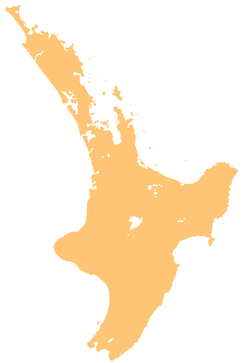Pahiatua
| Pahiatua | |
|---|---|
 |
|
| Coordinates: 40°27′12″S 175°50′27″E / 40.45333°S 175.84083°ECoordinates: 40°27′12″S 175°50′27″E / 40.45333°S 175.84083°E | |
| Country |
|
| Region | Manawatu-Wanganui |
| District | Tararua District |
| Founded | 1881 |
| Settled | 28 February 1882 |
| Incorporated (borough) | 25 July 1892 |
| Founded by | W. W. McCardle |
| Electorate | Wairarapa |
| Government | |
| • Mayor | Tracey Collis |
| Elevation | 103 m (341 ft) |
| Population (June 2016) | |
| • Total | 2,510 |
| Time zone | NZST (UTC+12) |
| • Summer (DST) | NZDT (UTC+13) |
| Postcode(s) | 4910 |
| Area code(s) | 06 |
| Website | [ ] |
Pahiatua is a rural service town in the south-eastern North Island of New Zealand with an urban and rural population of over 4,000. It is between Masterton and Woodville on State Highway 2 and the Wairarapa Line railway, 60 kilometres (37 mi) north of Masterton and 30 kilometres (19 mi) east of Palmerston North. It is usually regarded as being in the Northern Wairarapa, but for local government purposes it is in the Tararua District, which encompasses Eketahuna, Pahiatua, Woodville and Dannevirke.
Unusually for a town of its size Pahiatua has retained several amenities that were lost to similar towns around New Zealand in the 1980s and 1990s, in particular banking, postal services, and a cinema. The town is served by four banks, a post office, a supermarket, four schools (3 Primary, 1 Secondary), a volunteer fire brigade, and a public library.
There are conflicting accounts of how the town acquired its name. When translated from Māori, the name Pahiatua means "god's resting place". The explanation accompanying this translation is that a chief fleeing from his enemies was led by his war god to this hill to seek refuge. However, the town's founder, William Wilson McCardle, claims to have given it its name.
The Wellington Land Board decided in December 1880 to offer land in the Pahiatua Block for settlement. This consisted of 12,000 acres (4,900 ha), of which 3,000 acres (1,200 ha) was offered on a deferred payment basis. Applications for the land closed in February the following year, but there seems to have been little interest at first. Sales of land from the original offer continued over the next few years.
The Pahiatua village was not a settlement initiated by the government, but rather one that had its origin in land speculation. Several subdivisions were established by private landholders including W. W. McCardle, H. Manns, A. W. and Henry Sedcole, and W. Wakeman. It is claimed that the first settlers were John Hall who arrived on 28 February 1881, followed by John Hughes the next day. These men, plus the brothers of Hughes and their families, comprised Pahiatua's population the first summer. Precisely when the town of Pahiatua came into being is not clear as it has not been established when McCardle's first land sale took place. However, by the summer of 1883 he was advertising grassed suburban sections, "improved" acres, and other unimproved lots. In November 1885 he sought to dispose of a large portion of one of his subdivisions at an auction in Napier.
...
Wikipedia

